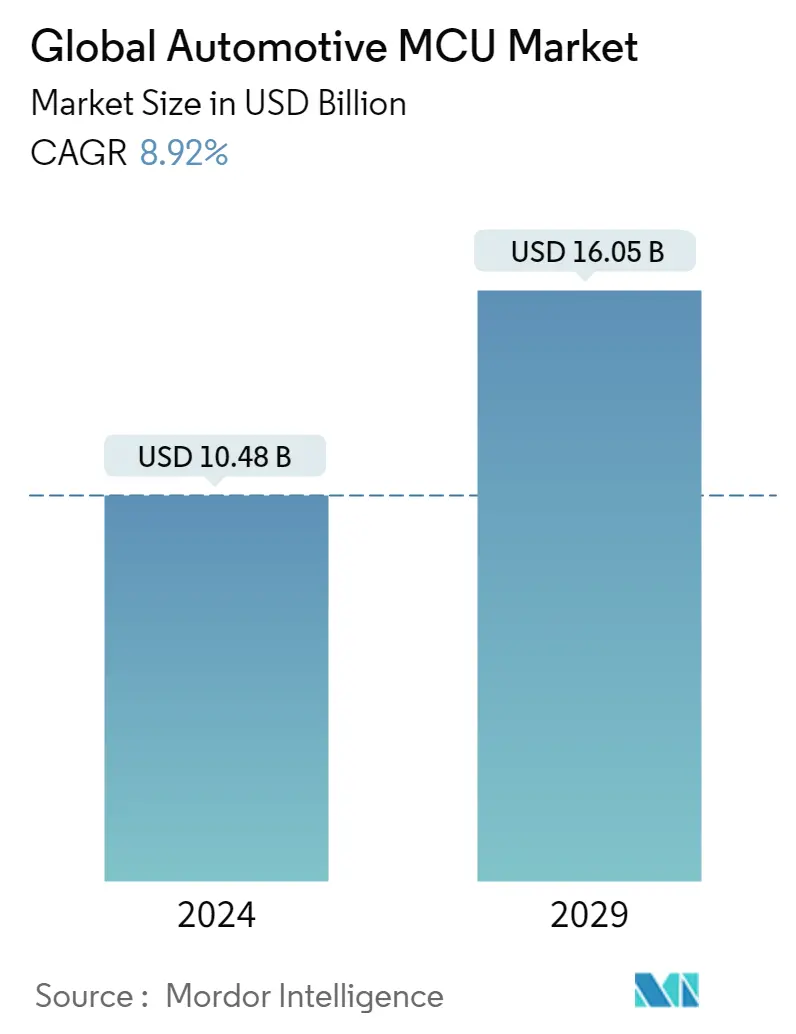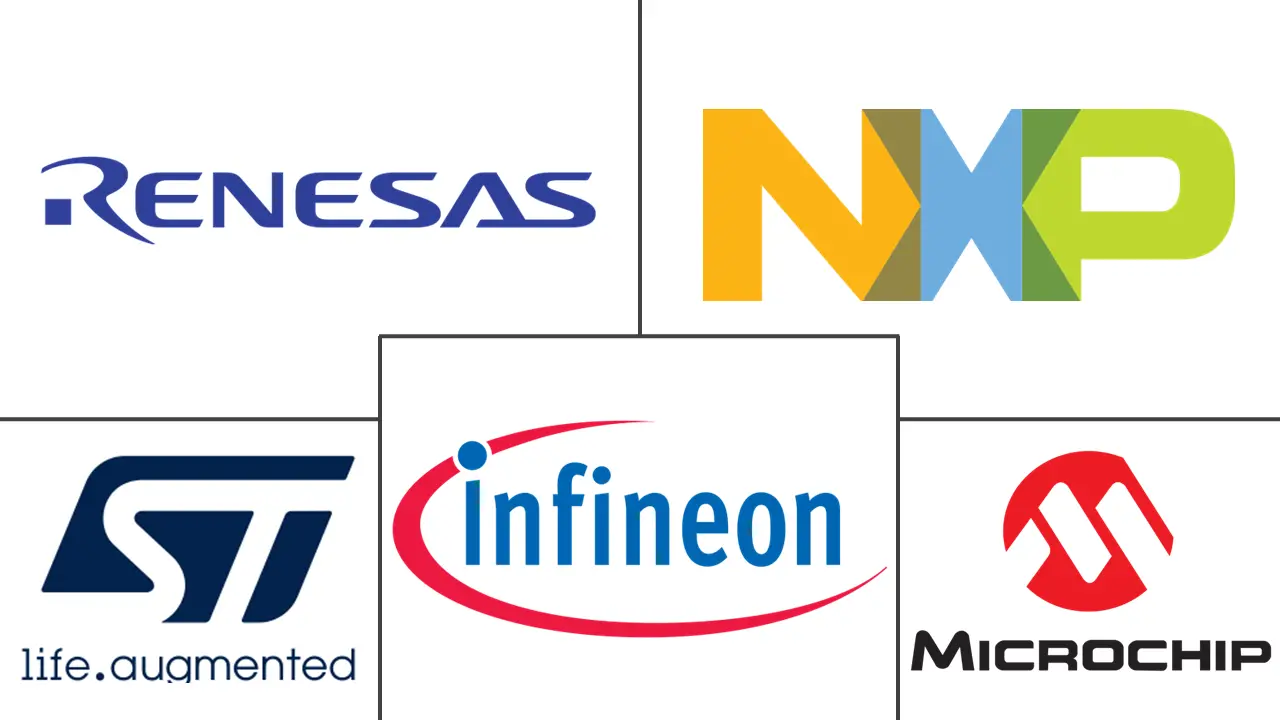Market Size of Global Automotive MCU Industry

| Study Period | 2019 - 2029 |
| Market Size (2024) | USD 10.48 Billion |
| Market Size (2029) | USD 16.05 Billion |
| CAGR (2024 - 2029) | 8.92 % |
| Fastest Growing Market | Asia-Pacific |
| Largest Market | North America |
| Market Concentration | Medium |
Major Players
*Disclaimer: Major Players sorted in no particular order |
Automotive Microcontrollers Market Analysis
The Global Automotive MCU Market size is estimated at USD 10.48 billion in 2024, and is expected to reach USD 16.05 billion by 2029, growing at a CAGR of 8.92% during the forecast period (2024-2029).
An increased demand for devices designed for extreme operating conditions, providing real-time response and high reliability, even in extreme temperatures, and incorporating features for functional safety to meet automotive design challenges, is expected to offer lucrative opportunities for growth of the studied market.
- The rise in automation has generated a significant need for microcontrollers responsible for the automatic operation of vehicle functions. MCUs are being used in automobiles to perform automatic functions like keeping the exhaust system clean, distributing electricity to various vehicle components, and reducing fuel consumption. Further, the electrification of vehicles is creating a need for new and specialized MCUs that are optimized for the needs of electric vehicles (EVs). To cater to the upsurge in demand for EVs, companies in the market are innovating advanced products and investing in extensive R&D projects.
- For instance, aiming to keep the impetus going for zonal architecture-related solutions, in February 2022, ST released Stellar E MCUs, a new offering optimized for software-defined EVs Built around 32-bit, 300 MHz Arm Cortex-M7 cores. The MCUs feature up to 2 MB of on-chip Flash and 16 Kbyte of cache per core. The new MCUs, an extension of the Stellar family, are meant to be powerful, centralized domain and zone controllers to simplify design and scalability for a zonal architecture automobile. Also, the new MCUs aim to allow for easy control of wide-bandgap power electronics, such as silicon carbide, which has become a mainstay for efficient power conversion in EVs.
- Additionally, in July 2021, Sterling Gtake E-mobility Ltd, a manufacturer of motor control units for electric vehicles, announced that it had bagged an order worth INR 60 crore from a leading electric two-wheeler maker. The company said it is also in the advanced stages of discussions with over 20 electric vehicle (EV) manufacturers to supply motor control units (MCUs) for different vehicle types, including two-wheelers and three-wheelers passenger vehicles and commercial vehicles.
- On the flip side, as the global automotive sector is recovering from a slump in sales caused by Covid-19, another crisis is dampening its revival. A global semiconductor shortage disrupts global automotive production and may cause a delay in the sales of new vehicles. Microcontrollers, a crucial component of electronic control units used in modern infotainment systems, anti-lock braking systems (ABS), advanced driver assist systems (ADAS), and other electronic stability systems are in short supply forcing carmakers to reduce output. Resultantly, the carmakers are selectively idling plants until the shortage eases. However, the market is expected to make quick progress in the near future.
- Moreover, the possibilities of operational failure of the automotive MCUs in extreme climatic conditions, coupled with their design complexity, might hamper the growth of the studied market.
Automotive Microcontrollers Industry Segmentation
An MCU is an intelligent semiconductor IC consisting of a processor unit, memory modules, communication interfaces, and peripherals. The global automotive MCU market is segmented by product type (8-bit,16-bit, 32-bit), application (powertrain and chassis, safety and security, body electronics, and telematics and infotainment), vehicle type (passenger ICE vehicle, commercial ICE vehicle, and electric vehicles), and geography. The segmentation comprises an in-depth coverage of the global revenue generated from the sale of application-specific consumer analog ICs and unit shipments.
| Segmentation - By Product | |
| 8-bit | |
| 16-bit | |
| 32-bit |
| Segmentation - By Application | |
| Powertrain and Chassis | |
| Safety and Security | |
| Body Electronics | |
| Telematics and Infotainment |
| Segmentation - By Vehicle Type | ||||||
| Passenger ICE vehicle | ||||||
| Commercial ICE vehicle | ||||||
|
| Segmentation - By Geography | |
| North America | |
| Europe | |
| Asia-Pacific | |
| Rest of the World |
Global Automotive MCU Market Size Summary
The automotive microcontroller (MCU) market is poised for significant growth, driven by the increasing demand for advanced vehicle automation and electrification. As vehicles become more automated, the need for MCUs to manage functions such as exhaust system cleanliness, electricity distribution, and fuel efficiency is rising. The shift towards electric vehicles (EVs) further amplifies this demand, necessitating specialized MCUs tailored to the unique requirements of EVs. Companies are actively innovating and investing in research and development to create advanced products that meet these evolving needs. For instance, ST's Stellar E MCUs, designed for software-defined EVs, exemplify the industry's push towards integrating powerful, centralized domain controllers to enhance vehicle design and scalability. However, the market faces challenges, including a global semiconductor shortage that disrupts production and delays vehicle sales, as well as potential operational failures of MCUs in extreme climatic conditions.
The market landscape is characterized by moderate fragmentation, with key players like Infineon Technologies, Microchip Technology, and NXP Semiconductors leading the charge. These companies are continuously evolving their offerings to keep pace with rapid technological advancements and changing consumer preferences. The introduction of new MCU families, such as Infineon's AURIX TC4x and Nuvoton's NUC131U series, highlights the industry's commitment to enhancing vehicle safety, performance, and connectivity. Additionally, the Asia-Pacific region is emerging as a significant hub for semiconductor manufacturing, further bolstering the market's growth prospects. The region's increasing adoption of hybrid electric vehicles, driven by environmental concerns and government subsidies, is expected to contribute to the market's expansion. Despite the challenges, the automotive MCU market is anticipated to progress steadily, supported by ongoing innovations and strategic collaborations among industry players.
Global Automotive MCU Market Size - Table of Contents
-
1. MARKET INSIGHTS
-
1.1 Market Overview
-
1.2 Industry Attractiveness - Porter's Five Forces Analysis
-
1.2.1 Bargaining Power Of Suppliers
-
1.2.2 Bargaining Power Of Buyers
-
1.2.3 Threat Of New Entrants
-
1.2.4 Threat Of Substitutes
-
1.2.5 Intensity Of Competitive Rivalry
-
-
1.3 Value Chain Analysis
-
1.4 Assessment of the Impact of Covid-19 on the Market
-
1.5 Technology Snapshot
-
-
2. MARKET SEGMENTATION
-
2.1 Segmentation - By Product
-
2.1.1 8-bit
-
2.1.2 16-bit
-
2.1.3 32-bit
-
-
2.2 Segmentation - By Application
-
2.2.1 Powertrain and Chassis
-
2.2.2 Safety and Security
-
2.2.3 Body Electronics
-
2.2.4 Telematics and Infotainment
-
-
2.3 Segmentation - By Vehicle Type
-
2.3.1 Passenger ICE vehicle
-
2.3.2 Commercial ICE vehicle
-
2.3.3 Electric Vehicle
-
2.3.3.1 BEV
-
2.3.3.2 HEV
-
2.3.3.3 PHEV
-
2.3.3.4 FCEV
-
-
-
2.4 Segmentation - By Geography
-
2.4.1 North America
-
2.4.2 Europe
-
2.4.3 Asia-Pacific
-
2.4.4 Rest of the World
-
-
Global Automotive MCU Market Size FAQs
How big is the Global Automotive MCU Market?
The Global Automotive MCU Market size is expected to reach USD 11.41 billion in 2025 and grow at a CAGR of 8.92% to reach USD 17.50 billion by 2030.
What is the current Global Automotive MCU Market size?
In 2025, the Global Automotive MCU Market size is expected to reach USD 11.41 billion.

